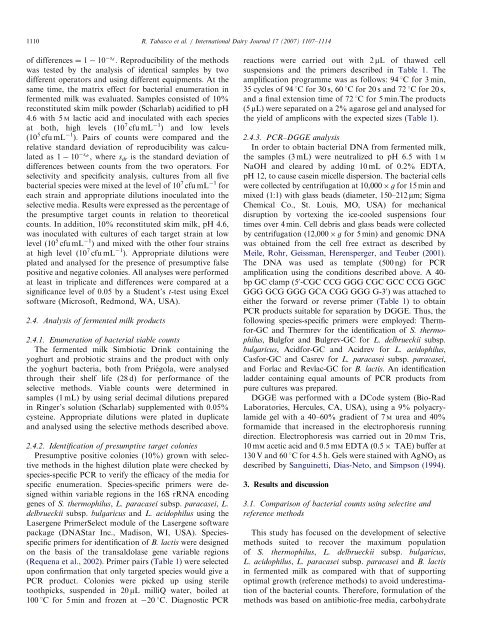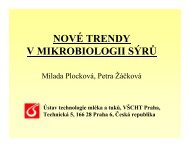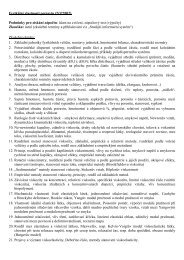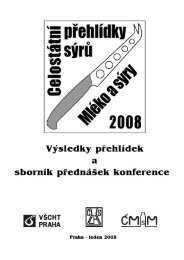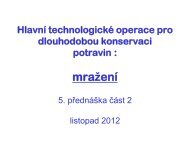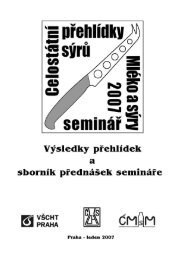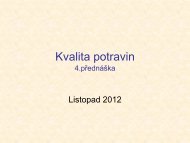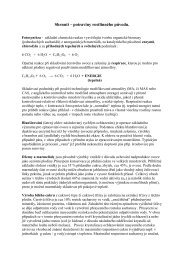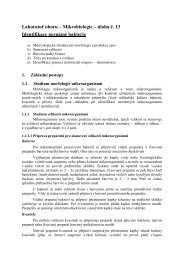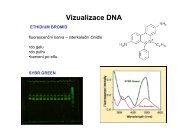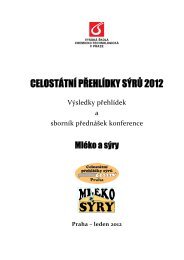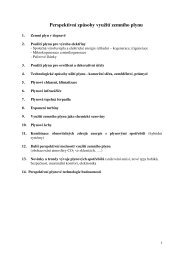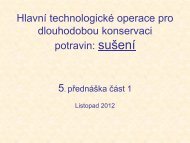Selective enumeration and identification of mixed cultures of ...
Selective enumeration and identification of mixed cultures of ...
Selective enumeration and identification of mixed cultures of ...
You also want an ePaper? Increase the reach of your titles
YUMPU automatically turns print PDFs into web optimized ePapers that Google loves.
1110<br />
<strong>of</strong> differences ¼ 1 10 sd . Reproducibility <strong>of</strong> the methods<br />
was tested by the analysis <strong>of</strong> identical samples by two<br />
different operators <strong>and</strong> using different equipments. At the<br />
same time, the matrix effect for bacterial <strong>enumeration</strong> in<br />
fermented milk was evaluated. Samples consisted <strong>of</strong> 10%<br />
reconstituted skim milk powder (Scharlab) acidified to pH<br />
4.6 with 5 M lactic acid <strong>and</strong> inoculated with each species<br />
at both, high levels (10 7 cfu mL 1 ) <strong>and</strong> low levels<br />
(10 5 cfu mL 1 ). Pairs <strong>of</strong> counts were compared <strong>and</strong> the<br />
relative st<strong>and</strong>ard deviation <strong>of</strong> reproducibility was calculated<br />
as 1 10 sdr , where sdr is the st<strong>and</strong>ard deviation <strong>of</strong><br />
differences between counts from the two operators. For<br />
selectivity <strong>and</strong> specificity analysis, <strong>cultures</strong> from all five<br />
bacterial species were <strong>mixed</strong> at the level <strong>of</strong> 10 7 cfu mL 1 for<br />
each strain <strong>and</strong> appropriate dilutions inoculated into the<br />
selective media. Results were expressed as the percentage <strong>of</strong><br />
the presumptive target counts in relation to theoretical<br />
counts. In addition, 10% reconstituted skim milk, pH 4.6,<br />
was inoculated with <strong>cultures</strong> <strong>of</strong> each target strain at low<br />
level (10 5 cfu mL 1 ) <strong>and</strong> <strong>mixed</strong> with the other four strains<br />
at high level (10 7 cfu mL 1 ). Appropriate dilutions were<br />
plated <strong>and</strong> analysed for the presence <strong>of</strong> presumptive false<br />
positive <strong>and</strong> negative colonies. All analyses were performed<br />
at least in triplicate <strong>and</strong> differences were compared at a<br />
significance level <strong>of</strong> 0.05 by a Student’s t-test using Excel<br />
s<strong>of</strong>tware (Micros<strong>of</strong>t, Redmond, WA, USA).<br />
2.4. Analysis <strong>of</strong> fermented milk products<br />
2.4.1. Enumeration <strong>of</strong> bacterial viable counts<br />
The fermented milk Simbiotic Drink containing the<br />
yoghurt <strong>and</strong> probiotic strains <strong>and</strong> the product with only<br />
the yoghurt bacteria, both from Prie´gola, were analysed<br />
through their shelf life (28 d) for performance <strong>of</strong> the<br />
selective methods. Viable counts were determined in<br />
samples (1 mL) by using serial decimal dilutions prepared<br />
in Ringer’s solution (Scharlab) supplemented with 0.05%<br />
cysteine. Appropriate dilutions were plated in duplicate<br />
<strong>and</strong> analysed using the selective methods described above.<br />
2.4.2. Identification <strong>of</strong> presumptive target colonies<br />
Presumptive positive colonies (10%) grown with selective<br />
methods in the highest dilution plate were checked by<br />
species-specific PCR to verify the efficacy <strong>of</strong> the media for<br />
specific <strong>enumeration</strong>. Species-specific primers were designed<br />
within variable regions in the 16S rRNA encoding<br />
genes <strong>of</strong> S. thermophilus, L. paracasei subsp. paracasei, L.<br />
delbrueckii subsp. bulgaricus <strong>and</strong> L. acidophilus using the<br />
Lasergene PrimerSelect module <strong>of</strong> the Lasergene s<strong>of</strong>tware<br />
package (DNAStar Inc., Madison, WI, USA). Speciesspecific<br />
primers for <strong>identification</strong> <strong>of</strong> B. lactis were designed<br />
on the basis <strong>of</strong> the transaldolase gene variable regions<br />
(Requena et al., 2002). Primer pairs (Table 1) were selected<br />
upon confirmation that only targeted species would give a<br />
PCR product. Colonies were picked up using sterile<br />
toothpicks, suspended in 20 mL milliQ water, boiled at<br />
100 1C for 5 min <strong>and</strong> frozen at 20 1C. Diagnostic PCR<br />
ARTICLE IN PRESS<br />
R. Tabasco et al. / International Dairy Journal 17 (2007) 1107–1114<br />
reactions were carried out with 2 mL <strong>of</strong> thawed cell<br />
suspensions <strong>and</strong> the primers described in Table 1. The<br />
amplification programme was as follows: 94 1C for 3 min,<br />
35 cycles <strong>of</strong> 94 1C for 30 s, 60 1C for 20 s <strong>and</strong> 72 1C for 20 s,<br />
<strong>and</strong> a final extension time <strong>of</strong> 72 1C for 5 min.The products<br />
(5 mL) were separated on a 2% agarose gel <strong>and</strong> analysed for<br />
the yield <strong>of</strong> amplicons with the expected sizes (Table 1).<br />
2.4.3. PCR–DGGE analysis<br />
In order to obtain bacterial DNA from fermented milk,<br />
the samples (3 mL) were neutralized to pH 6.5 with 1 M<br />
NaOH <strong>and</strong> cleared by adding 10 mL <strong>of</strong> 0.2% EDTA,<br />
pH 12, to cause casein micelle dispersion. The bacterial cells<br />
were collected by centrifugation at 10,000 g for 15 min <strong>and</strong><br />
<strong>mixed</strong> (1:1) with glass beads (diameter, 150–212 mm; Sigma<br />
Chemical Co., St. Louis, MO, USA) for mechanical<br />
disruption by vortexing the ice-cooled suspensions four<br />
times over 4 min. Cell debris <strong>and</strong> glass beads were collected<br />
by centrifugation (12,000 g for 5 min) <strong>and</strong> genomic DNA<br />
was obtained from the cell free extract as described by<br />
Meile, Rohr, Geissman, Herensperger, <strong>and</strong> Teuber (2001).<br />
The DNA was used as template (500ng) for PCR<br />
amplification using the conditions described above. A 40bp<br />
GC clamp (5 0 -CGC CCG GGG CGC GCC CCG GGC<br />
GGG GCG GGG GCA CGG GGG G-3 0 ) was attached to<br />
either the forward or reverse primer (Table 1) to obtain<br />
PCR products suitable for separation by DGGE. Thus, the<br />
following species-specific primers were employed: Thermfor-GC<br />
<strong>and</strong> Thermrev for the <strong>identification</strong> <strong>of</strong> S. thermophilus,<br />
Bulgfor <strong>and</strong> Bulgrev-GC for L. delbrueckii subsp.<br />
bulgaricus, Acidfor-GC <strong>and</strong> Acidrev for L. acidophilus,<br />
Casfor-GC <strong>and</strong> Casrev for L. paracasei subsp. paracasei,<br />
<strong>and</strong> Forlac <strong>and</strong> Revlac-GC for B. lactis. An <strong>identification</strong><br />
ladder containing equal amounts <strong>of</strong> PCR products from<br />
pure <strong>cultures</strong> was prepared.<br />
DGGE was performed with a DCode system (Bio-Rad<br />
Laboratories, Hercules, CA, USA), using a 9% polyacrylamide<br />
gel with a 40–60% gradient <strong>of</strong> 7 M urea <strong>and</strong> 40%<br />
formamide that increased in the electrophoresis running<br />
direction. Electrophoresis was carried out in 20 mM Tris,<br />
10 mM acetic acid <strong>and</strong> 0.5 mM EDTA (0.5 TAE) buffer at<br />
130 V <strong>and</strong> 60 1C for 4.5 h. Gels were stained with AgNO3 as<br />
described by Sanguinetti, Dias-Neto, <strong>and</strong> Simpson (1994).<br />
3. Results <strong>and</strong> discussion<br />
3.1. Comparison <strong>of</strong> bacterial counts using selective <strong>and</strong><br />
reference methods<br />
This study has focused on the development <strong>of</strong> selective<br />
methods suited to recover the maximum population<br />
<strong>of</strong> S. thermophilus, L. delbrueckii subsp. bulgaricus,<br />
L. acidophilus, L. paracasei subsp. paracasei <strong>and</strong> B. lactis<br />
in fermented milk as compared with that <strong>of</strong> supporting<br />
optimal growth (reference methods) to avoid underestimation<br />
<strong>of</strong> the bacterial counts. Therefore, formulation <strong>of</strong> the<br />
methods was based on antibiotic-free media, carbohydrate


